
There’s no question I’m a Forza fan through and through. Playing on a 106″ screen in cockpit view feels pretty close to the real thing, but one thing was missing from my Xbox One racing experience — a racing wheel. The problem with Xbox One racing wheels comes down to price, with the cheapest racing wheels with force feedback being around the $400USD mark until recently. At that price, they cost more than the console themselves, and the question remains: are they worth it? Our Logitech 920 review takes a look at Logitech’s Driving Force Racing Wheel for the Xbox One and PC, and answers that question as the racing wheel joins our Top Picks of 2016.
Table of contents
Specifications
The Logitech G920 Driving Force racing wheel has the following features and specifications:
- Software Support: Logitech Gaming Software
- Connection Type: USB
- USB Protocol: USB 2.0
- USB Speed: Full Speed
- Wheel:
- Rotation: 900 degrees lock-to-lock
- Hall-effect steering sensor
- Dual-Motor Force Feedback
- Helical gearing with anti-backlash hardware
- Overheat safeguard
- Height: 270 mm (10.63 in)
- Width: 260 mm (10.24 in)
- Depth: 278 mm (10.94 in)
- Weight without cables: 2.25 kg (4.96 lb)
- Pedals:
- Nonlinear brake pedal
- Patented carpet grip system
- Textured heel grip
- Self-calibrating
- Height: 167 mm (6.57 in)
- Width: 428.5 mm (16.87 in)
- Depth: 311 mm (12.24 in)
- Weight without cables: 3.1 kg (6.83 lb)
- Materials:
- Wheel spokes: Anodized aluminum
- Wheel cover Hand-stitched leather
- Steering shaft: Steel
- Shifter paddles: Brushed stainless steel
- Mounting clamps: Glass-filled nylon
- Pedal frames and arms: cold rolled steel
- Pedal faces: Brushed stainless steel
- Pedal piston sleeves: Polyoxymethylene thermoplastic (POM)
- System requirements: Xbox One or PC with powered USB port
- Games that support Logitech force feedback racing wheel
- Xbox One: Forza Motorsport 6, Forza Motorsport 5, Forza Horizon 2, Forza Horizon 2: Storm Island, Forza Horizon 2 Presents Fast & Furious, Project Cars, and Dirt Rally
- PC: Assetto Corsa, F1 2015, Project Cars, Dirt Rally, iRacing, Eurotruck Simulator 2, Live for Speed, Distance, American Truck Simulator, and Need for Speed 2016
- 2-year limited hardware warranty
What’s in the Box
- 1x Logitech G920 steering wheel
- 1x Pedal set
- 1x Power adapter
- 1x User documentation
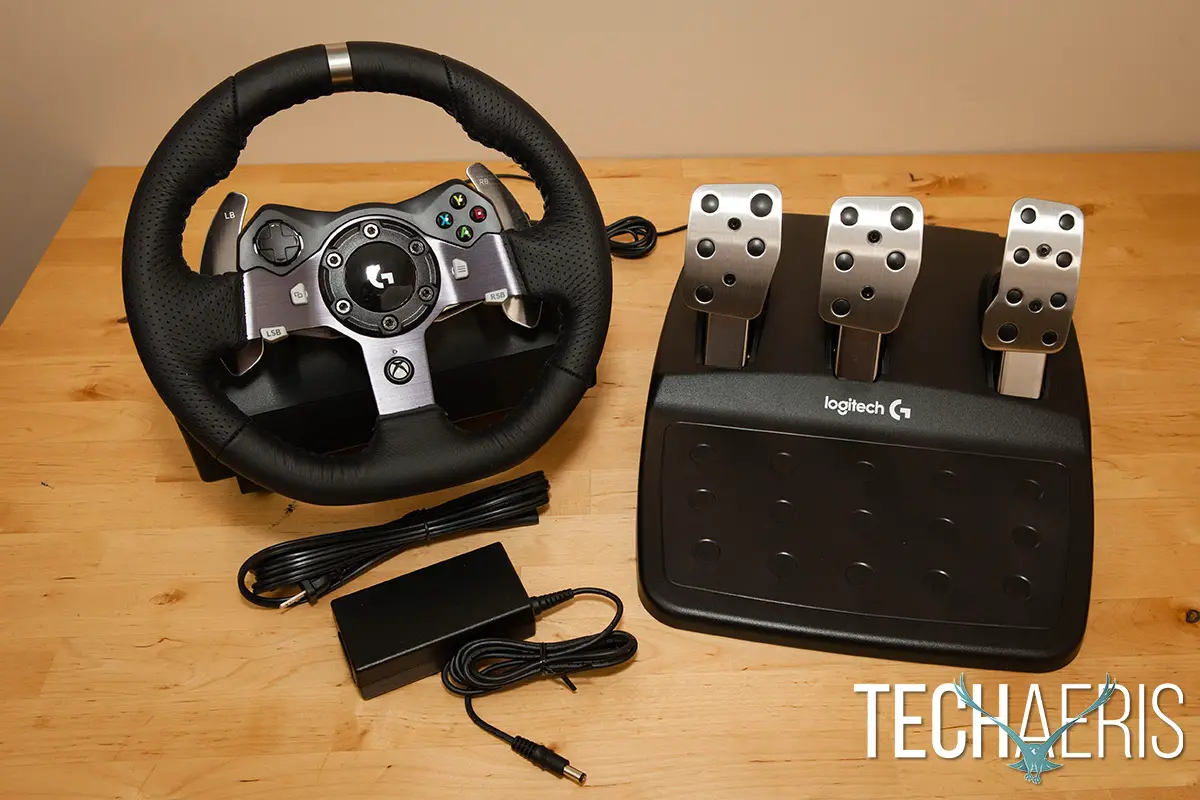
Design
The first thing I noticed when I picked up the Logitech G920 Driving Force Racing Wheel box was the sheer weight of it. The next thing I noticed when I took the Logitech G920 out of the box was that fresh new car leather smell…
Racing Wheel
On the outside, the G920 racing wheel is wrapped in high-quality, hand-stitched leather. Centered at the top of the wheel is a steering wheel stripe which lets you know at a glance what direction your wheel is pointing. The outer wheel is attached to three black anodized aluminum spokes. In the middle of these spokes is a circular metal piece with the Logitech G logo in the middle. Above the horizontal spokes, you’ll find the main button control unit. The left side contains the directional pad (D-pad), while the right houses the A, B, X, and Y buttons. The left spoke also houses the View and left stick buttons, while the right spoke houses the menu and right stick buttons. The Xbox Button is on the vertical spoke, below the center of the wheel, and an LED power indicator light sits just above that.

Behind the wheel are the left and right semi-automatic shifter paddles, made from brushed stainless steel. The paddles function as your left and right bumpers. Protruding from the base of the racing wheel are your mounting clamps which are manufactured from glass-filled nylon for high structural strength and rigidity — and once clamped onto a surface properly, you’d be hard-pressed to get them to slide loose. If you look at the front of the wheel, Logitech has loosely designed it to look like a car.

On the underside of the wheel, you’ll find a hollowed-out cavity that houses your ports and attached USB cable. The USB cable is wound around a cable management cleat in the middle, and really is my only complaint about the wheel. Measuring 6′, the USB cable is pretty short and although it may be o.k. for some setups, sitting 6′ away from a 106″ screen is overkill. The shortness was easily rectified with a USB extension cable, but it’s definitely worth keeping in mind depending on your setup. In addition to the USB cable, the underside contains a DB-9 female connection for the pedal unit, a male DB-9 connector for the optional shifter, the power connection, and 2 bolt mounting points for use to mount to a racing cockpit or seat.
As far as the internals are concerned, the racing wheel contains stainless steel ball bearings and helical gearing with dual-motor force feedback. These components not only provide durability but work to provide a realistic force simulation while reducing noise and vibration. The wheel also uses magnetic fields to sense the position of the wheel.
It would have been nice to see some sort of headset connection as well on the wheel so you don’t have to use a controller when using a headset.
Pedals
The pedals are definitely the heavier of the two main components and feature a clutch, brake, and throttle pedal — all crafted from brushed stainless steel. The pedal frames and arms are manufactured out of cold-rolled steel, and the piston sleeves are made using Polyoxymethylene Thermoplastic (POM) which gives the pedal arms a solid sleeve with low friction. Each of the pedals can be adjusted to the left or right by removing the bolts on the front of them. The clutch and throttle pedals have fairly easy travel, while the nonlinear brake pedal requires much more effort to push down, and is meant to provide a more responsive and accurate braking feel.
Under the pedals is a textured heel rest for resting your heels or other foot depending on your driving style. Flipping the pedal unit over, you’ll find rubber feet for gripping on a hard surface, a retractable carpet grip that can be released for use on carpet, and 6 bolt mounting points for use with a racing cockpit or seat.
Ease of Use
Setup of the Logitech G920 is pretty easy. Unwind the USB cable from the underside of the racing wheel and slip it into one of the cable grooves (Logitech recommends one of the inner ones). Next, plug the power adapter into the underside of the racing wheel, and slip it into another one of the cable grooves (again, Logitech recommends one of the outer ones). Last, attach the pedals to the steering wheel using the DB-9 connector (think old-school serial port), and slip the cord into one of the two remaining free cable grooves (another inner channel recommendation here). If you have the optional Driving Force Shifter, you’ll hook it up using a DB-9 connector as well. The DB-9 connection for the shifter is opposite gender than the pedals, so there’s no confusion where anything gets connected. Depending on your setup, you can wrap the cords multiple times around the cable management cleat to reduce cable slack.
Once you have the cables connected, you can attach the racing wheel to a desk or table, or mount it to racing seats or cockpits using the secure bolt-mounting system. Unfortunately, I don’t have a racing seat system, so a good old desk would have to do. The built-in clamping system features clamping feet, clamp knobs, and clamp extenders. Push down and rotate on the clamp knobs located on the top of the racing wheel to unlock them. Rotate the knobs to loosen the clamps, slip the racing wheel on your desk or table, and rotate the opposite direction to tighten. Once tightened, push down and rotate the clamp knobs to lock them in place. Without the clamp extenders, you can fit the wheel on a surface up to 2″ thick, while with the extenders you can fit it on thinner tables — during testing I attached it just fine to a roughly 1/4″ thick glass table.
After you’ve connected your cables and mounted your wheel, it’s time to plug it in and connect the USB cable to the Xbox One (or PC). When you connect it to the Xbox One, the racing wheel powers on and automatically calibrates by spinning the wheel back and forth before resting in the centered position. Use the buttons and d-pad on the wheel to launch your favourite supported racing game, and away you go!
Performance
Given my current setup, I already felt that Forza Motorsport was an outstanding racing experience. The Logitech G920 Driving Force Racing Wheel easily doubled the enjoyment and immersive factor of the game. Hands down.
The first thing you’ll want to do in any game is to head into the wheel settings screen and adjust your various options. The G920 features 900-degree lock-to-lock rotation, allowing you to rotate the wheel around 2.5 times. While you’ll want to race in simulation mode on Forza Motorsport, you may also want to fine-tune the wheel in the Advanced Settings. I mentioned above about the stiffness of the brake pedal, and using the default Forza settings, I felt like I was practically standing on the brake pedal in order for the car to slow down enough to corner. The Advanced Settings allow you to adjust your deceleration (braking) deadzone inside and outside, and I adjusted it to 5 on the inside and 50 on the outside and was much more pleased with the responsiveness.
The Advanced Settings you can adjust on the wheel in Forza include:
- Steering Axis Deadzone Inside/Outside
- Acceleration Axis Deadzone Inside/Outside
- Deceleration Axis Deadzone Inside/Outside
- Clutch Axis Deadzone Inside/Outside
- Handbrake Axis Deadzone Inside/Outside
- Vibration
- Force Feedback Scale
- Wheel Rotation
You’ll definitely want to play around with the settings and go for a few test laps before heading into races, but once you’ve tweaked these you shouldn’t really have to go back to them except for the occasional fine-tuning.
I’m no stranger to using a racing wheel, but it’s been some time since I fired up the Xbox 360 and used the original Microsoft force feedback steering wheel. Simply put, I was blown away by how much more realistic everything felt in Forza Motorsport 6 with the G920. You could definitely feel the pull around the corners, the vibration when you went off the edge of the track. I expected those things, but what I didn’t expect was the subtle feedback that the G920 provides. The NASCAR DLC for Forza Motorsport 6 is a prime example of this. Racing around the track, you can feel when you go over a bump from older asphalt to a freshly paved section. In the race where the game teaches you about NASCAR drafting, you can definitely feel the shake in the wheel from the dirty air to the lack of when you slip behind and get that smooth slipstream from the car ahead. With the attention to detail, and the feedback of the wheel, it’s really easy to immerse yourself into the game and almost forget that you’re not really driving.
Forza Horizon 2 was a bit of a different beast, but I remember that Forza Horizon felt a bit sloppier on the Xbox 360 with a wheel than Forza Motorsport 4 did. The same holds true on the Xbox One. While the games are in the same franchise, they have different developers and it shows — but it’s definitely no fault of the wheel itself. Forza Horizon 2 offers slightly looser driving as it is, and I was looking forward to going off-road with the wheel, expecting my arms to be stressed to the limit with the amount of feedback. Unfortunately, it was mostly little bumps and jiggles, nothing as intense as going off the track onto the grass in Forza Motorsport 6. Still, it made racing a lot more fun, but different techniques had to be employed, especially considering Forza Horizon‘s focus on street racing and stunting.
To be fair, each game is different, and the wheel works great in both Forza franchises but Forza Motorsport 6 definitely showcases what the Logitech G920 is capable of due to the level of the developer’s integration.
The G920 racing wheel is a lot quieter than I expected, and that’s definitely a bonus. When steering, you can hardly hear the gears turn, and as such it doesn’t detract from the gameplay. The louder sounds of course came from me stepping on the gas, brake, or clutch during the races. I usually race in automatic mode, but for the sake of testing tried both manual transmission and manual transmission with clutch in Forza Motorsport 6 and the wheel and pedals responded pretty much as I would expect them to. Not that I was any good at it, but the wheel definitely makes you feel like you want to push yourself and perhaps someday I just might become one of those uber manual transmission racers.

Price/Value
With an MSRP of $399USD ($499CAD), the Logitech G920 Driving Force Racing Wheel definitely isn’t cheap — but it’s also not the most expensive racing wheel setup on the market. Given the build quality and materials used, as well as the ease of use and great performance, I have to say that if you spend most of your time playing racing games on the Xbox One then you’ll definitely get your money’s worth out of the G920. Even better, Amazon currently has the wheel on sale for $286USD while Amazon.ca has it on for just under $430CAD which definitely makes the price a bit easier to swallow.
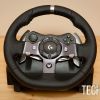

Wrap-up
If racing games are your thing, the Logitech G920 Driving Force Racing Wheel is something you’ll definitely want to consider with its great performance and build. Trust me, it takes an already great racing experience to the next level, and easily earns a spot in our Top Picks of 2016.
In some of our articles and especially in our reviews, you will find Amazon or other affiliate links. Any purchases you make through these links often result in a small amount being earned for the site and/or our writers. Techaeris often covers brand press releases. Doing this does not constitute an endorsement of any product or service by Techaeris. We provide the press release information for our audience to be informed and make their own decision on a purchase or not. Only our reviews are an endorsement or lack thereof. For more information, you can read our full disclaimer.
Last Updated on July 22, 2021.








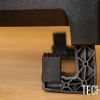
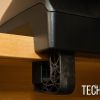



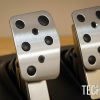










Comments are closed.